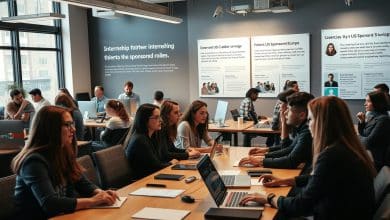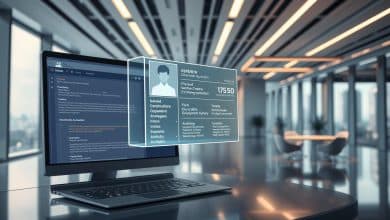How Can You Ace Career Fairs and Employer Info Sessions as a Newcomer?
Walking into a large event filled with company representatives can feel daunting for anyone new to the professional world. These gatherings, however, are packed with opportunities for students and recent graduates. They provide a unique chance to connect directly with hiring managers and learn about various industries.
Beyond simply looking for a job, these events offer many advantages. Participants can get their resumes reviewed, practice interviewing, and attend helpful workshops. This environment is ideal for building confidence in professional conversations.
For those unsure about their path, it’s an efficient way to explore different options. Engaging with employers helps uncover roles and industries one might not have considered. It turns uncertainty into a chance for discovery.
This guide offers practical advice for newcomers. The goal is to help them make strong impressions and build meaningful connections. With the right approach, these events become powerful stepping stones.
Before the Career Fair: Essential Preparations
The difference between a successful networking experience and a missed opportunity often lies in the preparation phase. Strategic groundwork transforms overwhelming events into productive encounters.
Conducting In-Depth Company Research
Thorough research begins with identifying which employers are attending the event. Creating a prioritized list based on career interests helps maximize time efficiency.
Start by examining each company’s Handshake profile for organizational overviews and student reviews. Then expand research to their official website to understand services and leadership.
Search for recent news articles and press releases to stay current on company developments. This comprehensive approach demonstrates genuine interest to recruiters.
Preparing Thoughtful Questions for Employers
Developing specific questions shows preparedness and motivation. Good inquiries can spark meaningful conversations and provide new insights.
Prepare a short list of questions about company culture, professional development, and day-to-day responsibilities. These topics reveal much about potential fit.
Thoughtful questions demonstrate that research has been conducted. They transform brief interactions into memorable exchanges that can lead to future opportunities.
Crafting a Professional Resume and Elevator Pitch
Two tools become particularly valuable when approaching company representatives: your resume and elevator pitch. These elements work together to present a complete professional picture.
Both documents require careful development before the event. They serve as your personal marketing materials during brief interactions.
Building a Resume That Stands Out
A professional resume serves as your primary introduction on paper. It should highlight your most relevant strengths and accomplishments.
Schedule an appointment with a career advisor for expert feedback. They can review content, formatting, and presentation quality.
Your resume should balance technical abilities with interpersonal skills. Include concrete examples from coursework, class projects, and work experience.
Even non-engineering jobs demonstrate valuable transferable skills. Volunteer work and extracurricular activities also showcase important strengths.
Developing a Confident Elevator Pitch
Your verbal introduction complements your written resume. This 30-60 second pitch summarizes your top three strengths.
Mix technical expertise with soft skills in your presentation. Share specific examples from projects that demonstrate these capabilities.
Clearly communicate what type of position you’re seeking. This helps recruiters quickly identify potential matches.
Practice your pitch multiple times to build confidence. Smooth delivery makes conversations feel natural rather than rehearsed.
Determining the Right Career Fair Attire
What you wear to professional recruitment events communicates your seriousness before you even speak. Employers form initial judgments based on appearance during brief encounters. Appropriate professional dress demonstrates respect for the opportunity.
First impressions matter greatly in these settings. Your choice of clothing sets the tone for conversations with company representatives. It shows you understand professional expectations.
Choosing Business Casual for Success
Business casual represents the ideal balance for most recruitment events. This dress code conveys professionalism while remaining accessible. It doesn’t require expensive formal wear.
For those without a suit, khakis or dress pants paired with a collared shirt work well. A professional blouse or button-down creates the right impression. The goal is looking polished and put-together.
Comfortable shoes are essential since these events involve considerable standing. Choose professional footwear that supports extended wear. This helps maintain confidence throughout the experience.
Many campus resources offer professional clothing assistance programs. Students can borrow appropriate outfits regardless of budget. Planning your attire in advance shows organizational skills.
Career Fairs Tips for a Confident Experience
Executing a well-planned strategy during the event itself separates passive attendees from active networkers. Practical organization and strategic engagement ensure every moment counts.
Arriving Prepared with Multiple Resume Copies
Bringing ample resume copies prevents missed opportunities with interested employers. Having extras allows for spontaneous conversations with additional representatives.
A professional portfolio keeps documents crisp and organized. This presents a polished image when handing materials to company contacts.
Make sure to organize all supplies before entering the venue. Easy access saves valuable time when approaching different booths.
Taking Strategic Notes During Interactions
Recording details during conversations strengthens follow-up efforts. Jotting down recruiter names and discussion points enables personalized communication later.
Bringing employer information sheets provides quick reference material. This helps maintain focus when time with each contact is limited.
Preparing for long lines requires patience and professionalism. Observing other interactions instead of phone use demonstrates serious intent.
Effective Networking and Communication Strategies
Building genuine connections requires more than just handing out resumes at professional gatherings. These events provide excellent practice for developing essential networking skills that serve professionals throughout their lives.
Successful networking involves creating meaningful dialogues rather than simple transactions. Candidates should approach each recruiter with authentic curiosity about their organization.
Engaging with Recruiters Confidently
Confident engagement begins with viewing conversations as two-way exchanges. Students should share their qualifications while demonstrating real interest in the employer’s perspective.
Active listening proves crucial during these interactions. Rather than waiting to speak, candidates should respond thoughtfully to the recruiter’s comments. This approach creates more natural and memorable discussions.
Body language significantly influences how employers perceive candidates. Maintaining eye contact, offering a firm handshake, and avoiding crossed arms convey professionalism. These non-verbal cues complement verbal communication effectively.
For students feeling uncertain, observing successful interactions provides valuable learning. Watching how confident candidates structure conversations offers practical examples to emulate.
Always request contact information or business cards from recruiters. If unavailable, record their full name and position for later follow-up through company websites. This ensures connections continue beyond the event.
Utilizing Career Fair Apps and Digital Resources>
Modern career fairs extend beyond physical interactions through specialized mobile applications. These digital tools provide essential resources that enhance the entire experience. They help candidates navigate events more efficiently.
Digital platforms offer powerful ways to connect with employers. They create multiple touchpoints beyond brief booth conversations. This approach maximizes exposure to companies of interest.
Exploring the Career Fair Plus App
The Career Fair Plus app serves as a comprehensive guide for event preparation. It provides access to the complete list of employers attending. Users can view interactive floor plans and receive real-time updates.
One valuable feature allows scheduling meetings with recruiters. This can help avoid long lines at popular booths. Candidates secure guaranteed face time with their top choices.
The resume drop function enables digital profile sharing. Students can express interest before, during, or after events. Recruiters may review materials at their convenience.
Leveraging Handshake and Other Platforms
Handshake integration offers another essential resource for job seekers. The platform provides detailed employer profiles and student reviews. It also lists open positions and upcoming events.
Following companies on Handshake signals continued interest after positive interactions. Users receive notifications when new jobs are posted. This keeps them informed about future opportunities.
Video guides help newcomers navigate these digital tools effectively. They demonstrate how to book meetings and optimize profiles. These resources support comprehensive preparation efforts.
Making the Most of Employer Follow-Up>
Following up with company representatives represents the crucial next step in converting promising interactions into tangible opportunities. The connections made during events require nurturing to demonstrate genuine interest and professionalism.
Sending Timely Thank-You Emails
Prompt communication shows respect for the recruiter’s time and keeps candidates fresh in their memory. Sending a follow-up email within 24 hours reinforces the positive impression made during initial conversations.
Each message should begin with genuine appreciation for the discussion. Mentioning specific topics from the conversation personalizes the communication and proves meaningful engagement occurred.
Candidates should clearly state their intended next steps in the email. This might include applying for a specific job discussed or exploring other positions that match their skills. If a particular opportunity was mentioned, submitting the application shortly after demonstrates serious interest.
Asking about interview timelines provides valuable information for managing expectations. This approach shows initiative without appearing pushy. For employers of greatest interest, finding contact information through company websites demonstrates resourcefulness.
The way follow-up emails are crafted can differentiate candidates from others who met the same recruiter. Thoughtful communication turns brief encounters into memorable connections that keep candidates top-of-mind during hiring decisions.
Conclusion
The comprehensive approach outlined in this resource empowers newcomers to navigate professional networking events effectively. What begins as an intimidating experience transforms into a manageable process through proper preparation and strategic execution.
This guide provides essential information for maximizing opportunities at employer gatherings. From research and professional presentation to confident communication and timely follow-up, each element builds toward success. The skills developed extend beyond single events, supporting long-term professional growth.
Students can reference these resources before, during, and after each opportunity. Implementing these strategies consistently builds confidence and expands professional networks. This practical way forward turns initial uncertainty into meaningful career pathways.
FAQ
What is the most important step to take before attending an employer information session?
How can someone create an elevator pitch that captures a recruiter’s attention?
What is considered appropriate business casual attire for these events?
Why is it beneficial to bring physical copies of a resume?
What should be included in a follow-up email after meeting an employer?
How can digital platforms like Handshake enhance the experience?
Published on: 15 de October de 2025

Galena Garcia
Galena Garcia is the visionary behind Portal Santista. With a degree in Business Administration and a specialization in Marketing for the financial sector, Galena brings years of experience from the corporate world, where she developed a deep passion for helping both businesses and individuals thrive financially.
Driven by a desire to share her knowledge with a broader audience, she founded Portal Santista—an online space dedicated to providing useful, practical, and reliable information on finance, marketing, and business management.
Outside of her professional life, Galena is an animal lover, a devoted reader of romantic novels, and loves spending fun moments with her nieces and nephews. Her unique blend of technical expertise and genuine care for people is what makes Portal Santista such a special place.






